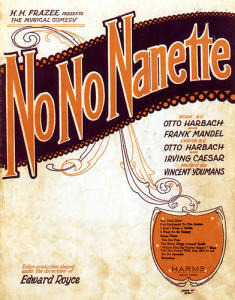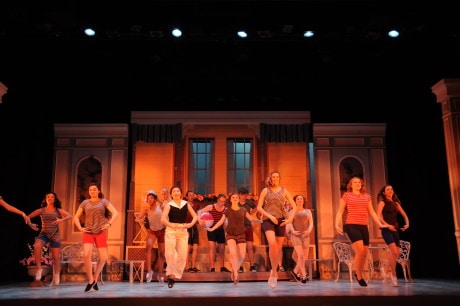A Frothy Revival of No, No, Nanette at American University
After a week in which corpses—remembered and actual—have littered just about every stage I’ve visited this week (beginning with Falling Out of Time at Theater J and ending with a very dark Othello at Shakespeare Theatre Company), it’s a relief to be able to say, ‘Yes, Yes’ to a new revival of No, No, Nanette at American University!

Imagine—if you can—a stage production that links the original 1925 lyrics of Irving Caesar and Otto Harbach to the music of Vincent Youmans and then pulls all the pieces together using the multi-award-winning version created by adaptor and director Burt Shevelove in 1971.
The Nanette of the tale is a rigidly-chaperoned young lady—played with ebullience and talent by Christine Miyashiro—who rebels against her wealthy guardians by sneaking off to the family’s supposedly empty residence in Atlantic City.
Of course, Nanette does not venture off alone. Accompanied by her co-conspirator, a saucy maid named Pauline—played by a wise-cracking and genuinely comic Mallorie Stern—and an ensemble of 15 jazz age guys and gals, Nanette and her friends sing and dance and cavort on the beach before the other characters descend upon them.
Among the new arrivals are Nanette’s suitor, Tom, an earnest young man played with great sincerity and charm by Joel Iscaro; her prim aunt Sue (a dowdy but noble Pat O’Connor) and her uncle Jimmy (Sam Baum), who makes his millions publishing Bibles on thin paper.
Some of the strongest performances in the musical are those of the family friends, Lucille (Julia Messer), who loves shopping, and Bill, the lawyer husband who must bail everyone out, played with fine showmanship by Seth Andrew Watring.
Two of the best songs in the show are their duet, “You Can Dance With Any Girl at All,” in Act Two, and Lucille’s blues number, “Where Has My Hubby Gone,” in Act Three.
It is Bill who hatches the plot that has everyone—including three floozies, played to great comic effect by Audra Gale, Aurora McLellan, and Alice Squeglia—converge at the beach house.
From there on, it’s a tale of philandering husbands, blackmailing broads, flappers who yearn to get married and the young men who hope to woo them, all told in a glorious medley of 16 song and dance numbers that are as fresh today as they were in the 1920s.
“Tea for Two”—sung by Tom and Nanette—has to be one of the most deeply felt marriage proposals ever written. Despite its familiarity, hearing it sung by these two young people is like hearing it for the first time.
“I Want to Be Happy”—which is reprised in past, present and future tenses, with intense changes in lighting—brings the house down.
All the musical numbers are great. They are enormously entertaining on their own, yet they move the plot along, embellishing the kind of witty lines and sexual innuendo that still make people laugh out loud.
Directed and choreographed by Karl Kippola, with Brandon Adams as music director and arranger, much of the success of this AU production is due to these two faculty professionals, who combine teaching theatre with award-winning commercial work in theaters across the country. No, No, Nanette is performed with two pianos, instead of an orchestra. And the ensemble singing is as good as it gets.
A lot of credit must also go to the brilliant stage management team, consisting of three students, Natalie Rine, Anna Kabis, and Robin Weiner, who manage to keep the cast moving despite the confines of a very small stage. There are constant comings and goings of course, with never a dull or awkward moment.
Barbara Tucker Parker and Stacey Hamilton, both costume professionals at AU, are responsible for the incredible array of 1920s garb, ranging from flapper dresses to bathing costumes and stiffly-pressed shirts with V-necked sweaters for the men.
The finale, featuring men in tuxedos and women in lace and beaded outfits, is stunning.
A single set—creating the façade of a palladium-style mansion—is the basis for both the indoor and outdoor scenes, with simple changes in furniture allowing the change in scene from a fine Manhattan townhouse to the so-called “summer cottage” on the sea. Samina Veith is the talented designer whose work has transformed stages, including the Folger and Theater J, throughout the DC area.

Lighting it all up is Jason Arnold, another AU artist who work has been seen at the Arena Stage, Olney Theatre Center, and Shakespeare Theatre Company, among others. The colors, projected by spotlight operators Stephen Bubniak and Manna Symone Middlebrooks, evoke the different moods and melodies of the music, which ranges from ballads and blues to tap-dancing and the Charleston. The only area in need of improvement at my performance was the sound amplification. Although there were a few exceptions, most of the young performers have not yet learned to project. Until everyone can bellow out his or her numbers, better miking is needed.
I found No, No Nanette to be a delight from beginning to end. It’s pure magic.
Running Time: Two hours, plus one short intermission.
No, No, Nanette plays through Saturday, March 26, 2016 at American University’s Greenberg Theatre – 4200 Wisconsin Avenue NW, in Washington, DC. For tickets, call the Box Office at (202) 885-2587, or purchase them online.
LINKS:
Review #1: ‘No, No, Nanette’ at American University by Patrick (PJ) McMahon.
Review #2: ‘No, No, Nanette’ at American University by Ravel Brickman.
RATING:




